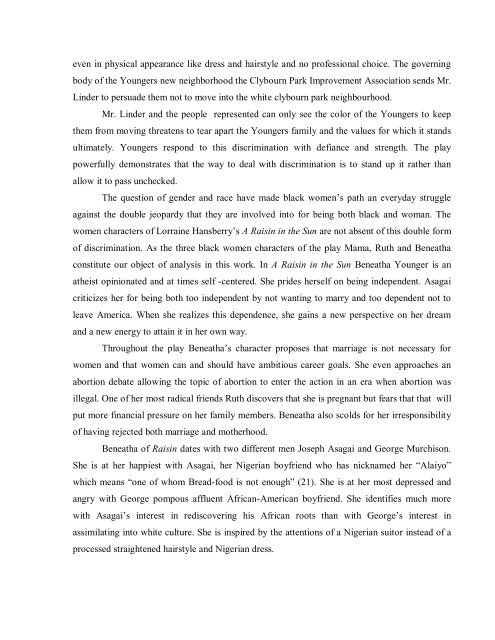A Multidisciplinary Research Journal - Devanga Arts College
A Multidisciplinary Research Journal - Devanga Arts College
A Multidisciplinary Research Journal - Devanga Arts College
Create successful ePaper yourself
Turn your PDF publications into a flip-book with our unique Google optimized e-Paper software.
even in physical appearance like dress and hairstyle and no professional choice. The governing<br />
body of the Youngers new neighborhood the Clybourn Park Improvement Association sends Mr.<br />
Linder to persuade them not to move into the white clybourn park neighbourhood.<br />
Mr. Linder and the people represented can only see the color of the Youngers to keep<br />
them from moving threatens to tear apart the Youngers family and the values for which it stands<br />
ultimately. Youngers respond to this discrimination with defiance and strength. The play<br />
powerfully demonstrates that the way to deal with discrimination is to stand up it rather than<br />
allow it to pass unchecked.<br />
The question of gender and race have made black women’s path an everyday struggle<br />
against the double jeopardy that they are involved into for being both black and woman. The<br />
women characters of Lorraine Hansberry’s A Raisin in the Sun are not absent of this double form<br />
of discrimination. As the three black women characters of the play Mama, Ruth and Beneatha<br />
constitute our object of analysis in this work. In A Raisin in the Sun Beneatha Younger is an<br />
atheist opinionated and at times self -centered. She prides herself on being independent. Asagai<br />
criticizes her for being both too independent by not wanting to marry and too dependent not to<br />
leave America. When she realizes this dependence, she gains a new perspective on her dream<br />
and a new energy to attain it in her own way.<br />
Throughout the play Beneatha’s character proposes that marriage is not necessary for<br />
women and that women can and should have ambitious career goals. She even approaches an<br />
abortion debate allowing the topic of abortion to enter the action in an era when abortion was<br />
illegal. One of her most radical friends Ruth discovers that she is pregnant but fears that that will<br />
put more financial pressure on her family members. Beneatha also scolds for her irresponsibility<br />
of having rejected both marriage and motherhood.<br />
Beneatha of Raisin dates with two different men Joseph Asagai and George Murchison.<br />
She is at her happiest with Asagai, her Nigerian boyfriend who has nicknamed her “Alaiyo”<br />
which means “one of whom Bread-food is not enough” (21). She is at her most depressed and<br />
angry with George pompous affluent African-American boyfriend. She identifies much more<br />
with Asagai’s interest in rediscovering his African roots than with George’s interest in<br />
assimilating into white culture. She is inspired by the attentions of a Nigerian suitor instead of a<br />
processed straightened hairstyle and Nigerian dress.



